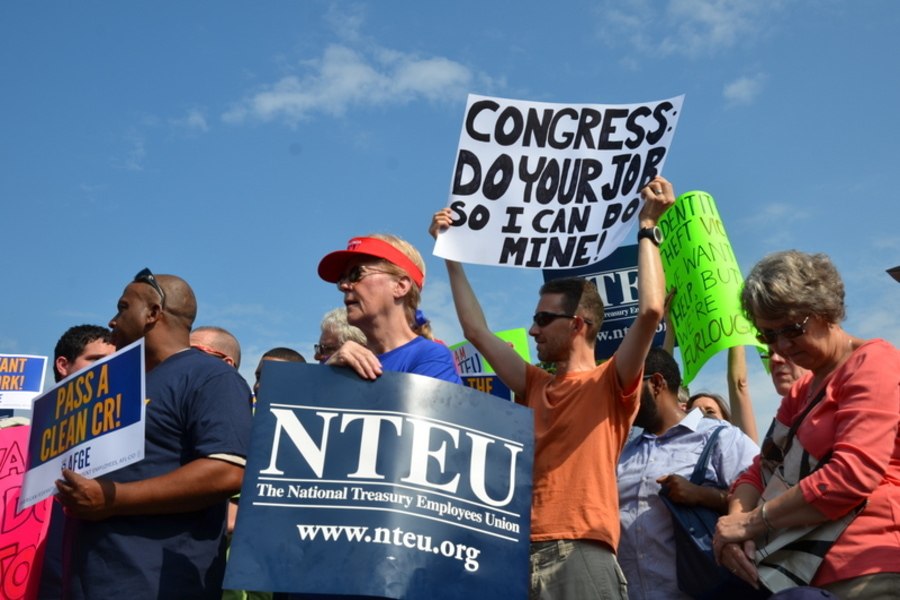Reductions in Force During Shutdowns

Published by The Lawfare Institute
in Cooperation With

Government appropriations expire on Sept. 30. Without additional funding, the federal government will shut down, temporarily furloughing large numbers of federal employees. The Trump administration views this looming shutdown as an opportunity to permanently reduce the size of the federal workforce. In a recent memorandum, the Office of Management and Budget (OMB) directed agencies to “use this opportunity to consider Reduction in Force (RIF) notices for all employees in programs, projects, or activities that satisfy all three of the following conditions: (1) discretionary funding lapses on October 1, 2025; (2) another source of funding ... is not currently available, and (3) the PPA is not consistent with the President’s priorities.” In short, the administration intends to treat the shutdown as a legal basis for permanent RIFs.
Historically, federal agencies have not used RIFs to manage shutdowns. Under the Antideficiency Act, shutdowns trigger temporary furloughs of non-excepted employees who are recalled once funding resumes and granted automatic back pay. Excepted employees—those allowed to work during a lapse in appropriations—remain on the job without pay but also receive back pay once the shutdown ends.
Using RIFs in this context is uncharted territory. Neither the Merit Systems Protection Board (MSPB) nor the federal courts have squarely addressed whether a lapse in appropriations legally justifies the permanent removal of federal employees. No statute expressly gives agencies more expansive authority to initiate RIFs during a shutdown. Existing precedent, however, provides reasons to think the courts may uphold such RIFs, provided the administration follows the proper procedures. Ultimately, Congress has the legislative authority to prevent future disruptions to the federal workforce.
Shutdown Furloughs Versus RIFs
Shutdown furloughs and RIFs serve different purposes and operate as separate tools of workforce management. Under the Antideficiency Act, federal agencies may not obligate or expend funds in excess of available appropriations. As a result, they may not retain the services of employees during a lapse in appropriations except “for emergencies involving the safety of human life or the protection of property.” OMB Circular A-11 requires agencies to develop contingency plans identifying the groups of “excepted employees” who will remain on duty during a shutdown.
In a 1995 opinion, the Office of Legal Counsel (OLC) identified four major categories of excepted employees:
- Employees whose compensation is financed by a resource other than annual appropriations.
- Employees needed to perform activities expressly authorized or implied by law.
- Employees needed to discharge the president’s constitutional duties and powers.
- Employees needed to protect life and property.
Agencies themselves determine which employees are designated “excepted” or “non-excepted.” Although these categories appear narrow, contingency plans are often shaped by political considerations. Presidents use contingency plans as bargaining chips in appropriations negotiations and as tools to sway public opinion.
Excepted employees must continue working during a shutdown but do not receive pay until Congress enacts appropriations. At times, they may experience an increased workload due to the absence of non-excepted employees. Shutdowns thus leave most federal employees exhausted and demoralized. During the 35-day shutdown in 2019, for example, employees at the Federal Aviation Administration and the Transportation Security Administration began calling in sick with greater frequency, leading to delays at the country’s busiest airports such as New York’s LaGuardia. Morale problems also often drive employees to leave federal service after a shutdown. Given existing staffing shortages at the Federal Aviation Administration, the National Weather Service, and other agencies, a shutdown could both temporarily and permanently disrupt critical public services that protect life and property.
Ultimately, however, shutdown furloughs are designed to be temporary. Once Congress restores appropriations, most employees return to work and receive back pay. Although shutdowns often have lasting effects on the workforce, the furloughs themselves are intended as a short-term compliance mechanism under the Antideficiency Act.
By contrast, agencies typically use RIFs to permanently reduce the size of their workforce after Congress has cut appropriations. Historically, RIFs have been closely tied to congressional funding decisions. Office of Personnel Management (OPM) regulations imply that agencies may use RIFs for reasons such as lack of work, shortage of funds, insufficient personnel ceiling, or reorganization—all common consequences of the appropriations process. Neither the statutes nor the regulations, however, explicitly address the application of RIFs following a lapse in appropriations.
By law, the criteria for determining which employees are excepted from furlough during a shutdown bear no relationship to the criteria for selecting employees for separation in a RIF. The Trump administration has increasingly sought to blur this distinction. Issued in February, Executive Order 14210 instructed agencies to “initiate large-scale reductions in force,” prioritizing employees “who are not typically designated as essential during a lapse in appropriations as provided in the Agency Contingency Plans.” As Bridget Dooling explains, “the categories used for RIF planning and those used for shutdown planning are apples and oranges.”
OMB’s recent memo goes further than shutdown furloughs, directing agencies to use the shutdown as an opportunity to issue RIF notices to “all employees” funded by discretionary funding that implement programs, projects, or activities deemed inconsistent with Trump’s priorities. This approach marks a sharp departure from the historical practice that has governed agency management during lapses in appropriations.
Justifying RIFs
Lawfully implemented RIFs have two components: a bona fide reason and procedure. Regarding procedure, RIFs are notoriously complicated and governed by vexing procedures. Most legal challenges focus not on whether the agency had a bona fide reason to conduct a RIF, but on whether it complied with required procedures. Agencies must prepare retention registers and provide each employee subject to the RIF with a minimum of 30 days’ notice. Failure to comply with these requirements threatens the validity of the RIF. Because the Trump administration has not issued any RIF notices related to the shutdown, it is unclear whether it will follow the required procedures. That said, its track record in federal court on RIF-related matters is poor.
The use of RIFs to address a lapse in appropriations raises questions about reasoning rather than procedure. No court has squarely addressed whether a temporary lapse in appropriations justifies a RIF. The statutory text does not state that a lapse in appropriations grants agencies more expansive authority to initiate RIFs than in other circumstances involving a shortage of funds. (Indeed, as discussed below, the statutory text does not explicitly authorize RIFs at all.) Existing precedent, however, suggests that courts might uphold a shutdown as a bona fide reason for initiating a RIF.
An agency has the burden of establishing by a preponderance of evidence that a RIF was “properly invoked due to management considerations of the character appropriately committed to agency discretion.” Agencies meet this burden by presenting evidence that the RIF was undertaken for one of the reasons specified in OPM’s regulations. The U.S. Court of Appeals for the Federal Circuit has stated that the “decision on the composition and structure of the work force reflects the kind of managerial judgment that is the essence of agency discretion, and is not meet for judicial reevaluation.” It went on to state that the court “will not disturb a reduction in force absent a clear abuse of discretion or a substantial departure from applicable procedures.”
The scope of review into an agency’s justification is narrow. As the MSPB has explained, “[o]nce it has been ascertained that an agency has in fact invoked the RIF regulations for one of the management reasons specified in [OPM’s regulations] ... , the Board has no authority to review the management considerations which underlie the exercise of agency discretion.”
Shortage of funds is a well-recognized basis for conducting a RIF. The MSPB has emphasized that “an agency has ‘broad management discretion to take action to avoid a [deficit situation],’ and that its authorities in this regard include the authority to conduct a reduction in force.” Both the MSPB and the Federal Circuit have held that the anticipation of a budget cut is sufficient to justify a RIF. In Cross v. Department of Transportation, the Federal Circuit stated: “Conducting a RIF because of an anticipated shortage of funds does not require that the shortage exist at the time of the RIF. There is no reason for agency officials who are aware of imminent legislation progressing through Congress to wait until the legislation is enacted before taking appropriate action.” Moreover, even when appropriations have increased, an agency may lawfully conduct a RIF if it determines that those funds are needed for other functions.
Given this broad standard, a federal court would likely conclude that a lapse in appropriations is a bona fide reason for initiating a RIF. An agency could demonstrate both that (a) it presently lacks funds to pay non-excepted employees and (b) ongoing negotiations will likely produce further reductions in appropriations. Provided proper procedures are followed, courts would likely uphold this decision as committed to agency discretion.
But what if Congress later restores funding? In Cook v. Department of the Interior, the MSPB addressed a similar case. The Department of the Interior notified employees of a pending RIF on Aug. 30, 1995. A month later, Congress enacted a continuing resolution that increased appropriations to a level sufficient to avoid furloughs. Section 111 of the continuing resolution specifically tied the increase to preserving the federal workforce. Even so, the MSPB rejected the argument that Congress had prohibited the RIF. Because furloughs and RIFs are legally distinct personnel actions, the board held that the department could still reasonably anticipate a future shortage of funds and thus lawfully proceed with the RIF.
The deferential standard used to assess the agency’s reason for initiating a RIF makes it difficult for employees to challenge the agency’s justification. The MSPB will entertain claims that the agency’s stated rationale was merely pretext for an impermissible personnel action, such as political retaliation, union activity, or discrimination on the basis of race, sex, or other protected categories. Yet courts and the MSPB have drawn a sharp distinction between managerial judgments about the composition of the workforce—which fall squarely within agency discretion—and prohibited personnel practices, which the civil service statutes forbid. Successful pretext claims typically involve highly targeted actions designed to remove or demote a particular individual under the guise of a RIF. For example, in Losure v. ICC, the MSPB held that a purported RIF was unlawful because it was in fact motivated by the employee’s association with a former official at the agency.
By contrast, large-scale RIFs that apply across an entire program, project, or activity are difficult to portray as pretext for personal animus or discrimination against particular employees. Unless employees can point to evidence of a discriminatory motive or procedural irregularities that substantially undermine the agency’s case, the MSPB will defer to the agency’s determination that the RIF was necessary. This dynamic is especially salient in the context of shutdown-related RIFs. Even if employees argue that the administration is exploiting a lapse in appropriations for political ends, the precedent suggests that courts would treat the decision as a permissible exercise of management discretion, provided the agency followed OPM’s procedural rules. Even if employees identify credible arguments to challenge these RIFs, the absence of a quorum at the MSPB will hinder their ability to attain timely reinstatement. In short, while individual employees may have theoretical avenues to contest a shutdown-related RIF, the combination of broad agency discretion and narrow judicial review makes such challenges extraordinarily difficult to win.
How Should Congress Respond?
The Trump administration plans to use RIFs as a bargaining chip. As a legal matter, these RIFs would likely survive judicial review if the administration follows the proper procedures. As a political matter, should Congress call the administration’s bluff? It depends.
Executive Order 14210 has already instructed agencies to initiate RIFs for employees who would be classified as non-excepted during a shutdown—the same category of employees described by the OMB memo. The Supreme Court has signaled that the order itself is lawful, meaning any challenge must target the specific implementation of RIFs by agencies. At least 148,000 federal employees have already left federal service. Although a shutdown could provide additional justification, many agencies would likely satisfy the deferential standard without the shutdown—especially if the appropriations law cuts agency spending. The legal viability of RIF challenges will likely turn on whether agencies follow proper procedures or on the constitutionality of the action, rather than on the agency’s stated rationale.
There appears, however, to be internal disagreement among executive branch officials about the direction of personnel policy. OMB’s memo suggests that OMB Director Russ Vought believes that agencies still have room to further reduce their workforces. But OPM—not OMB—must approve all RIF plans submitted by agencies. OPM Director Scott Kupor stated on Sept. 24 that RIFs and the deferred resignation program had already cut “too close to the bone” in some agencies. Kupor undoubtedly intends to aid the Trump administration’s efforts but has generally expressed a desire for more methodical approaches to personnel management. Agency leaders have told employees not to take the threat of RIFs seriously. These mixed signals cast doubt on whether most agencies will follow OMB’s plan to pursue additional RIFs.
At bottom, OMB’s memo amounts to a threat that agencies will simply continue the actions they have pursued for the past nine months. Why this would provide the Trump administration with meaningful leverage in negotiations is unclear.
Nevertheless, Congress has strong reasons to avoid a shutdown. The public relies on the policies and programs funded by appropriations. The longer a shutdown lasts, the more acutely people feel its effects. Moreover, a shutdown is not a “win” for federal employees with or without the threat of RIFs. They must pay mortgages, utility bills, and support their families. Even excepted employees who work throughout the shutdown must wait until Congress passes appropriations to get paid. Congress does federal employees no favors by allowing for an extended government shutdown. At the same time, it also does employees a disservice by allowing the administration to continue its wanton dismantling of the civil service.
Of course, Congress still has the legislative power, and it could use that authority in either narrow or broad ways to oversee the Trump administration’s efforts to shrink the federal workforce. Some congressional Republicans have already warned that the OMB memo is “unnecessary provocation” and gives “Democrats an excuse to vote against” a stopgap measure. To build support for appropriations legislation, Republicans could include provisions that limit future RIFs, especially in agencies of bipartisan concern such as the Department of Veterans Affairs and the National Oceanic and Atmospheric Administration. Congress has used similar tools before: Past appropriations laws have imposed personnel floors to prevent deliberate attempts to downsize agency workforces. For example, the fiscal year 1989 appropriations law provided that the average employment “shall not be less than 12,898 for the Department of Veterans Benefits.” Narrowly tailored measures could prevent the Trump administration’s future personnel policies from targeting agencies with bipartisan support.
More broadly, Congress could enact legislation that places clearer guardrails on the use of RIFs. The statutory authority that agencies cite as substantive authority—5 U.S.C. § 3502—is, frankly, puzzling. Section 3502 is a procedural statute; it governs how agencies should prepare retention registers. Its text does not expressly authorize RIFs, but agencies have long relied on OPM’s implementing regulations as a source of implicit authority. (Contrast Section 3502 with 22 U.S.C. § 4010a(a), which explicitly states that the “Secretary [of State] may conduct reductions in force” among foreign service officers.) In other areas of law, some judges argue that mere procedural provisions do not themselves confer substantive authority to act. The legislative history of Section 3502 reinforces this point. Congress enacted this provision to protect veterans and tenured employees—not authorize their removal. Nevertheless, agencies and courts rely on Section 3502 (perhaps erroneously) as providing agencies with substantive authority to initiate RIFs. Because Section 3502 is a creature of statute, Congress remains free to amend it, clarifying when and under what circumstances agencies may lawfully conduct RIFs.
In the end, the administration’s effort to use a shutdown as a springboard for permanent workforce cuts tests the limits of both law and politics. Courts are unlikely to second-guess large-scale RIFs so long as agencies follow the rules, leaving Congress as the real check on executive overreach. Whether lawmakers choose to act will determine if shutdowns remain temporary disruptions—or become a powerful tool for reshaping the federal workforce.



.jpg?sfvrsn=5a43131e_9)
